Valencian Paella
This post may contain affiliate links. See my disclosure policy.
It’s no wonder paella is the national dish of Spain because this delicious and drop-dead gorgeous dish is simply phenomenal! This Valencian paella recipe is a one-pot rice dish that’s easy to make and perfect for casual weeknights, a romantic dinner or for entertaining!
For more delicious paella recipes be sure to try my Seafood Paella and Squid Ink Paella!
Paella, paella, paella…it sounds like a romantic melody. And paella really does conjure up an image of romance, don’t you think? You’ve seen those movie scenes where the guy stops by the girl’s apartment with a bag of groceries in one hand and a paella pan in the other, ready for a romantic night in. This paella recipe is all you need for that perfect date night in!
One of the most famous of the world’s national dishes, paella – the word deriving from the Old French word paelle for “pan” – is also one of the most delicious with a colorful palette of ingredient options.
For the same reason I love Chinese stir fries, paella is such a great medium for adding lots of healthy veggies and you can create any combination under the sun. Paella makes for a wonderfully wholesome one-pot dish that lends itself to endless creativity.
And paella is just so doggone fun to make!
If you haven’t already gotten into the paella groove, you must!
The paella recipe we’re making today comes from Valencia, Spain. We toured Spain last Summer and Valencia was one of our stops.
A city with a rich culture and heritage, Valencia is known for its combining of history with ultra modernity. Its beautiful historic buildings are juxtaposed with futuristic structures reminiscent of something in a sci-fi movie. Indeed, Valencia is known as The City of Arts and Sciences.
Pretty stunning, isn’t it?
Let’s talk briefly about tradition.
A truly traditional Valencian paella recipe would include rabbit and snails in addition to the chicken but I couldn’t find rabbit – and I didn’t want to find snails – so those two ingredients have been omitted.
Traditional Paella Valenciana also includes a third kind of bean, a white bean, that’s hard to find outside of Spain.
But our paella captures the spirit of Valencia with its other traditional ingredients like chicken, beans, artichokes, peppers, rosemary and its rich saffron-colored rice.
Modern technology has almost completely replaced the traditional open-fire method of making paella, but Valencian cooks have found ways to replicate the flame-kissed characteristics of paella by adding smoked paprika and rosemary (for a woodsy flavor) and adding artichokes to darken the color. Another popular method is to cook the paella on a grill.
This past weekend I had an opportunity to attend a Paella Party in Seattle sponsored by Culinary Collective, an importer of gourmet cultural foods from Spain and Peru. I was able to meet several wonderful brands in person and sample their products. And I was also able to finally meet the producers of a brand I absolutely love and have been using for nearly 2 years: Aneto. They’re the Barcelona-based makers of my favorite broths.
I was also able to soak up some paella inspiration from the Aneto team and dream about our upcoming trip to Spain.
Pro Tip for Making Paella
For a dish as famous and beloved as paella, it packs a lot of controversy, even though there’s no clear consensus on the rules of paella-making. At least when it comes to ingredient combinations. Indeed, many of the traditional “rules” are broken even in Valencia.
Still, there is at least one rule that every paella purist will insist upon. Above and beyond all:
DO NOT STIR THE RICE.
To do so constitutes the ultimate offense and comes with a heavy penalty. Okay, not really. But do not stir the rice. And the reason behind that isn’t just nonsensical tradition. It is the key to paella’s flavor. Not stirring allows you to achieve the ever sacred socarrat – that cripsy golden brown crust that forms at the bottom and is the most coveted part of paella.
Now that we’ve covered that important base, are you ready to create a paella party of your own?
For our Paella Valencia we’re using hands-down the best paella base you’ll find anywhere. It’s made by Aneto, my favorite broth manufacturer, and it’s an all-natural broth made in Barcelona from the freshest vegetables, meats, herbs and spices and slow-cooked to achieve a flavor that is simply unmatched. No need to add saffron, it’s already in the broth.
For more information about Aneto and what sets them apart, join us as we take a tour of their factory in Spain.
Aneto’s Valencian Paella Cooking Base is amazing and will absolutely transform your paella!
Matiz’ paella rice is grown is Spain and the small grains perform particularly well for paella, yielding a perfect texture and consistency.
Matiz’ roasted Piquillo peppers are hand-picked in northern Spain and produced without any chemicals. They’re slow-roasted over an open wood fire and have in incredibly rich and complex flavor. I found myself popping several in my mouth while laying them out on the paella. They are so good!
You’ll also need a paella pan. You can use a regular skillet but a paella pan is constructed for optimal results. Some come with dimples on the base for even heat distribution. And whatever size you choose will depend on your cooking surface and how many people you plan to feed. I used a 34 cm paella pan for this dish.
Valencian Paella Recipe
Now let’s roll up our sleeves and make some paella!
Heat some oil in the paella pan over medium heat, then add and brown the chicken pieces on both sides.
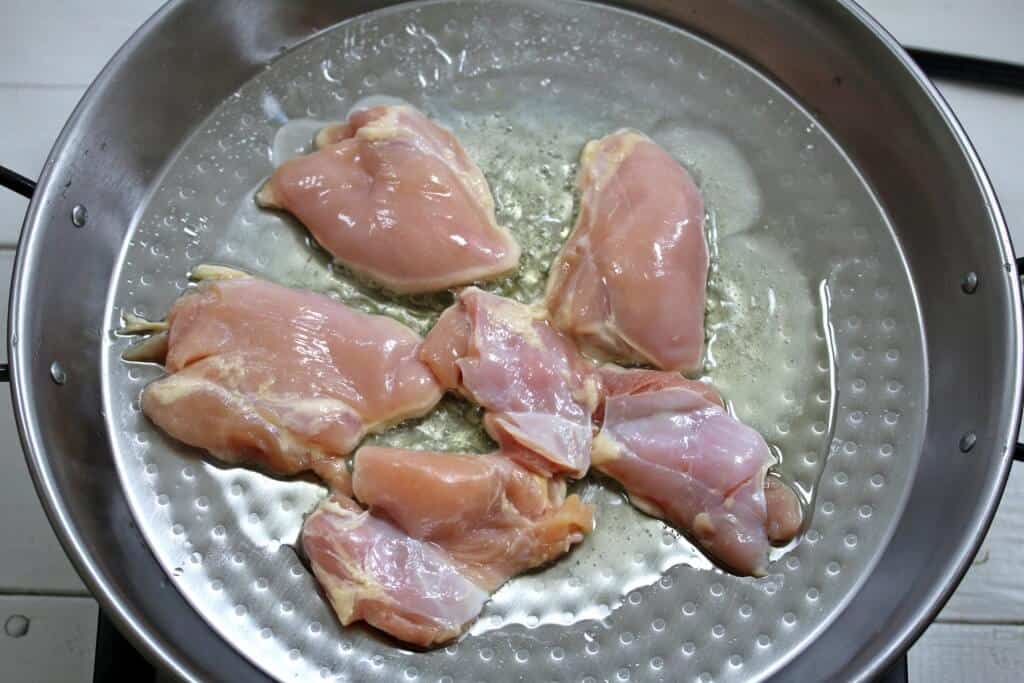
Transfer the chicken to a plate. Add the onions and garlic and cook until soft and translucent, 4-5 minutes.
Add the green beans and lima beans and cook for a couple of minutes.
Add the paella rice, stir and cook for another 3-4 minutes, adding a little more oil if needed. Add a little salt and pepper.
Position the beans the way you’d like them to appear in the final dish.
Pour the paella broth base into the pan.
Remember the cardinal rule: DO NOT STIR.
Once the mixture begins to bubble, position the chicken pieces in the pan.
Place the artichokes around the pan.
Place some strips of piquillo peppers on top.
Place some sprigs of rosemary on top.
Remember the idea is to position everything the way you want it to appear in the finished dish.
Simmer over medium-low heat for about 20 minutes or until the rice is done, rotating the pan as needed to cook the rice towards the outside of the rim. At the end of the cooking you can increase the heat for a few minutes to further caramelize the socarrat, the crispy golden-browned bottom.
Place the paella pan on the table and let the party begin!
Enjoy!
Save This Recipe
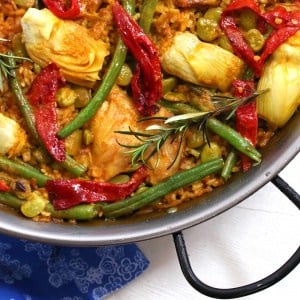
Valencian Paella
Ingredients
- 4 boneless chicken thighs
- 1 small yellow onion ,chopped
- 2 cloves garlic ,minced
- 6 ounces fresh uncooked green beans, washed and ends trimmed
- 3/4 cup frozen Lima beans
- 1 1/2 cups Matiz Paella Rice
- 3/4 teaspoons salt
- 1/4 teaspoon freshly ground black pepper
- 1 34 ounce carton Aneto Valencian Paella Cooking Base
- 7 ounce can plain artichoke hearts ,drained
- About 2 ounces Matiz Piquillo Peppers ,cut into strips
- A few small rosemary sprigs
- Smoked paprika for sprinkling
- Lemon wedges for serving
Instructions
- Heat the oil in the paella pan over medium heat, then add and brown the chicken pieces on both sides. Transfer the chicken to a plate.
- Add the onions and garlic and cook until soft and translucent, 4-5 minutes. Add the green beans and lima beans and cook for a couple of minutes. Lastly add the paella rice, stir and cook for another 3-4 minutes, adding a little more oil if needed. Add the salt and pepper.
- Position the beans the way you'd like them to appear in the final dish. Pour the paello broth into the pan. Remember the cardinal rule: DO NOT STIR. Once the mixture begins to bubble, position the chicken pieces in the pan followed by the artichokes and then top with the Piquillo peppers. Place some sprigs of rosemary on top.
- Simmer uncovered for about 20 minutes or until the rice is done, rotating the pan as needed to cook the rice towards the rim of the pan. At the end of the cooking you can increase the heat for a few minutes to further caramelize the socarrat, the crispy golden-browned bottom.
- Sprinkle with some smoked paprika and serve with lemon wedges.
Video
Notes
Nutrition
Photos courtesy David Iliff and Diego Delso via cc licensing

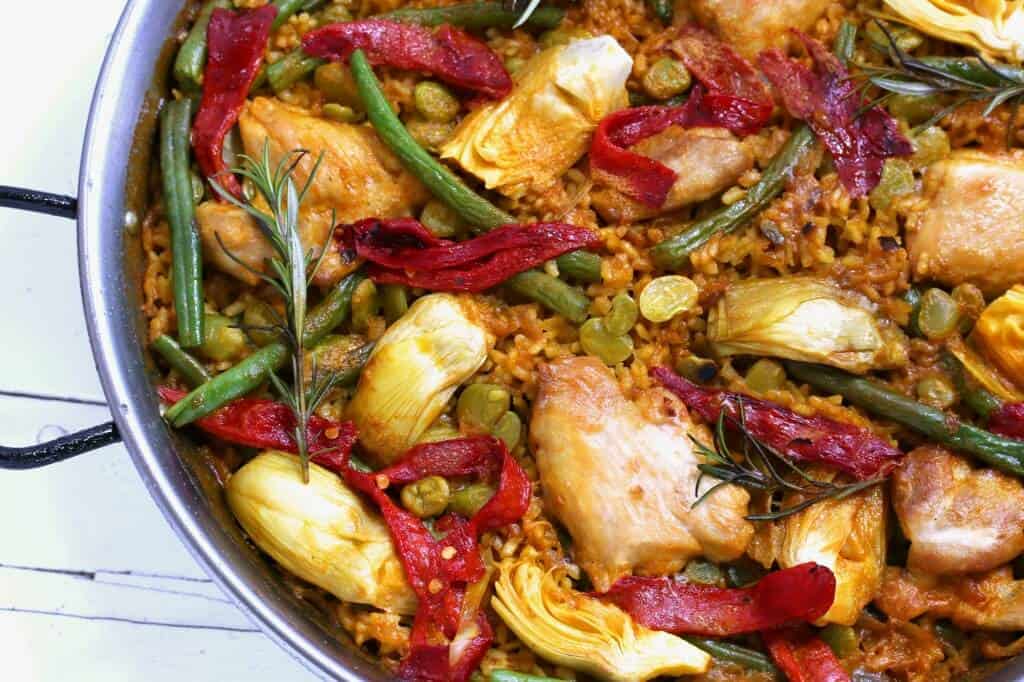
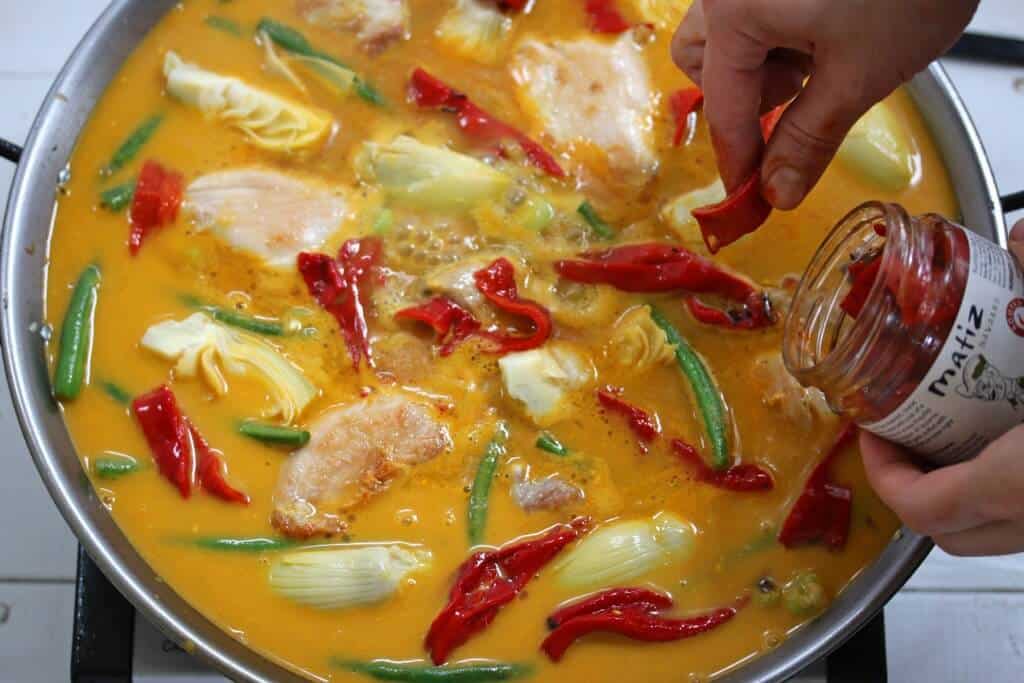
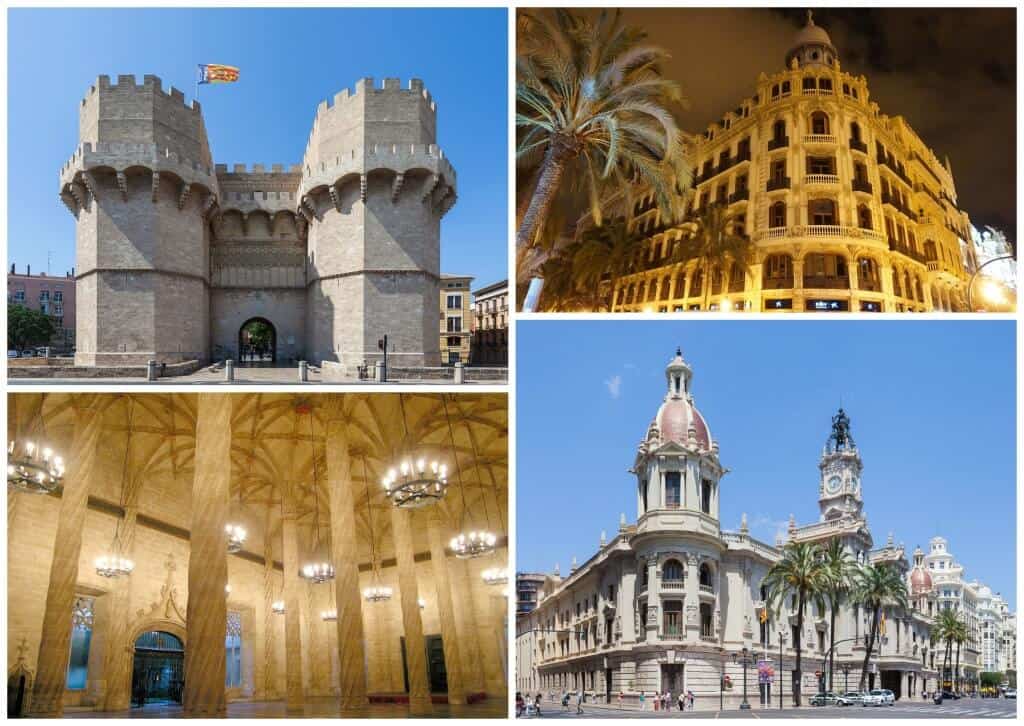

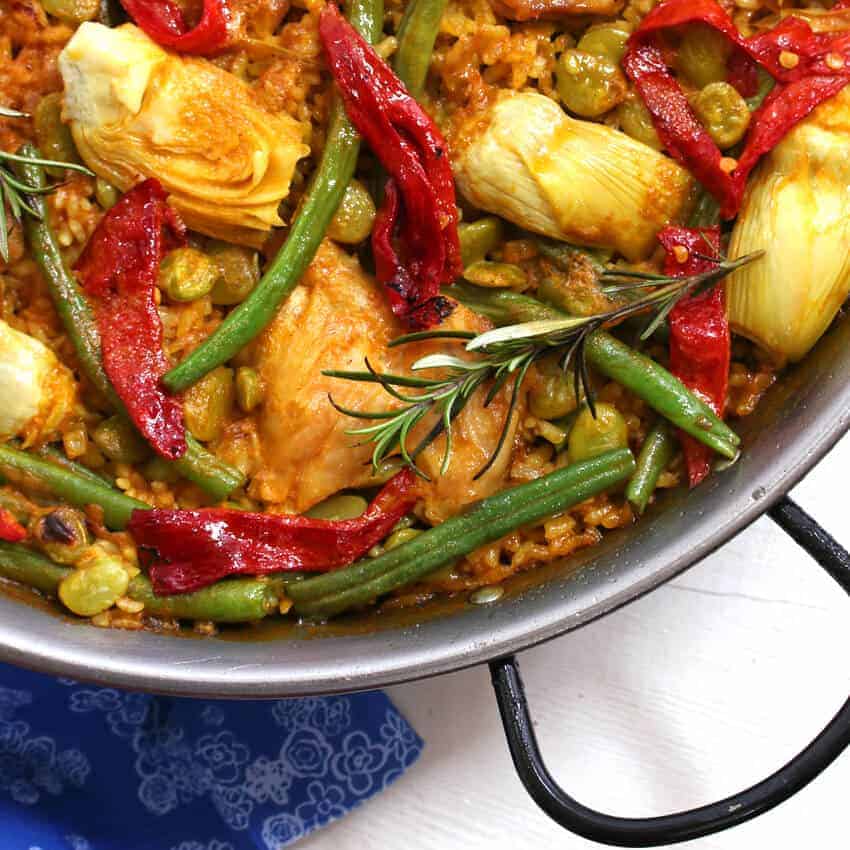
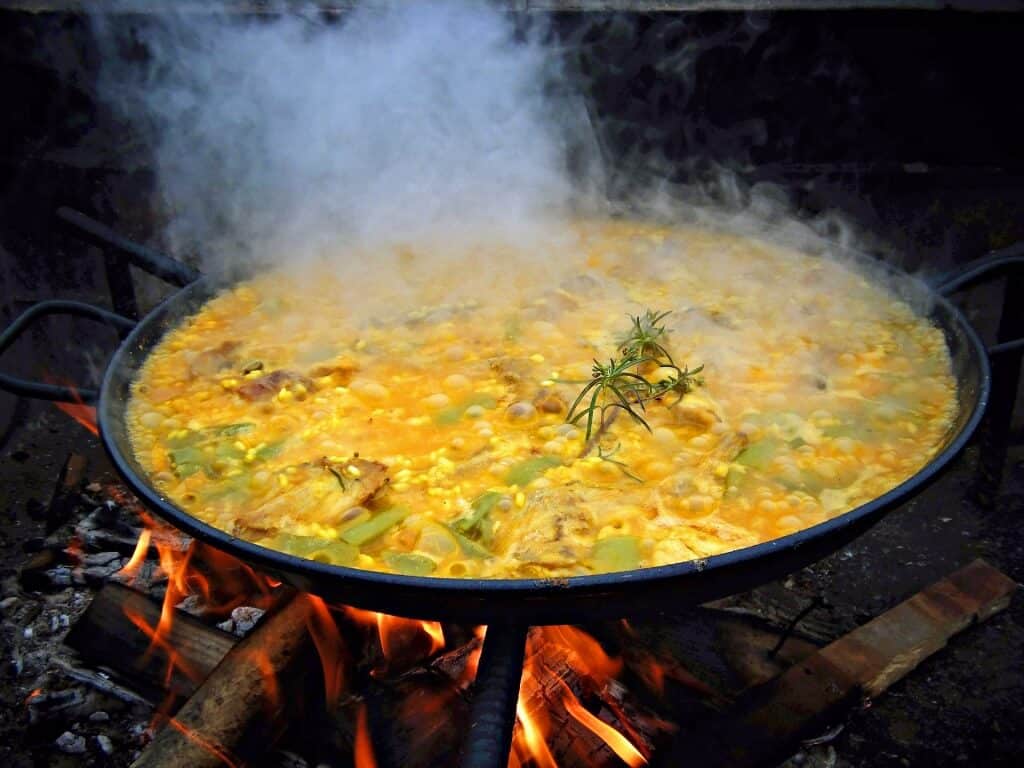
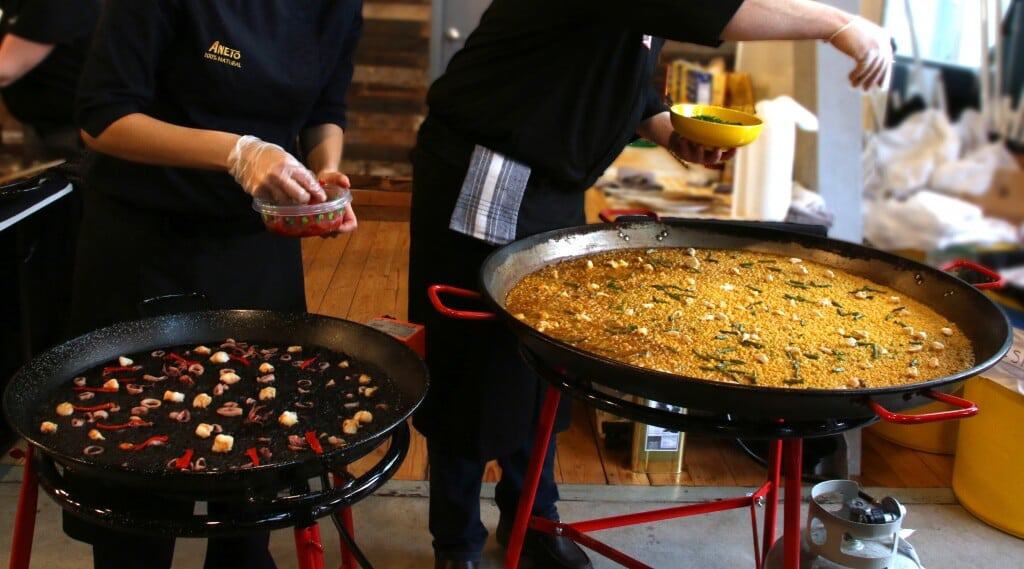
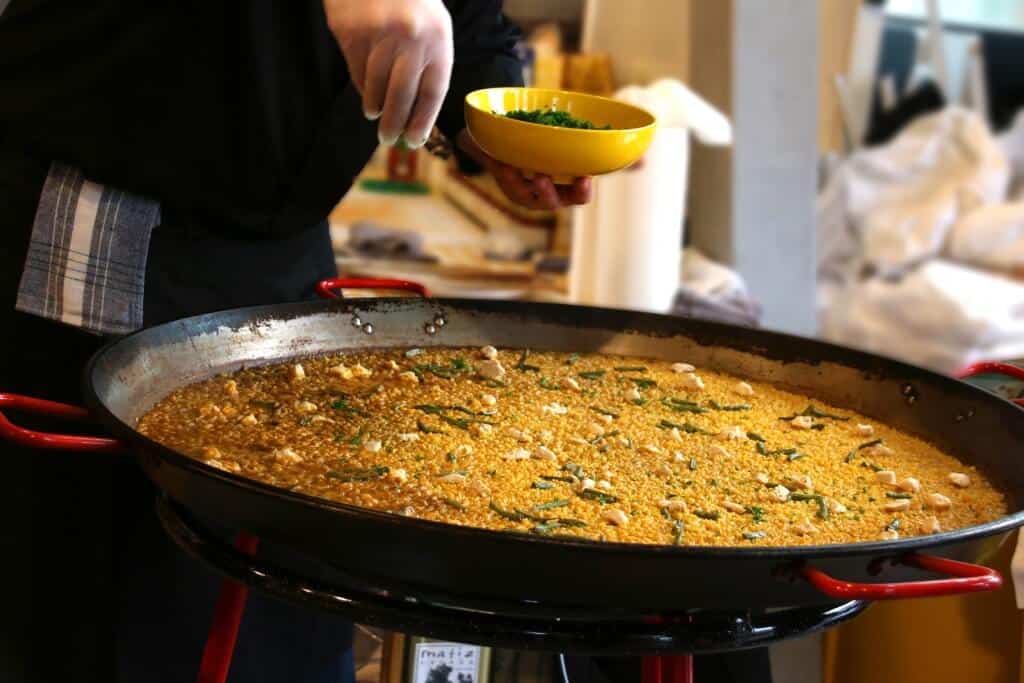
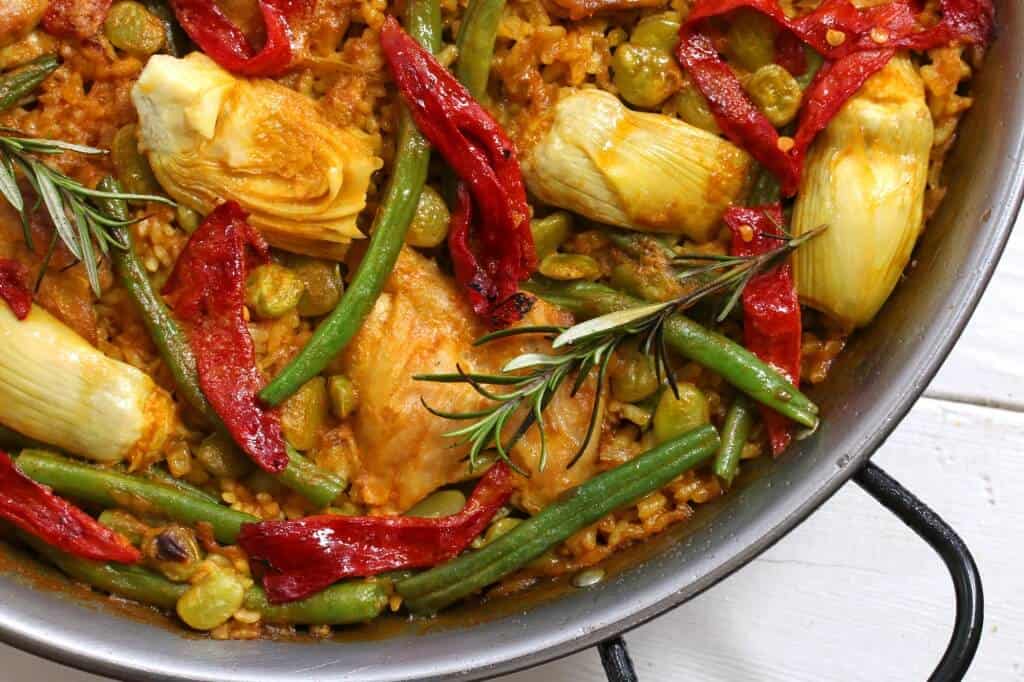
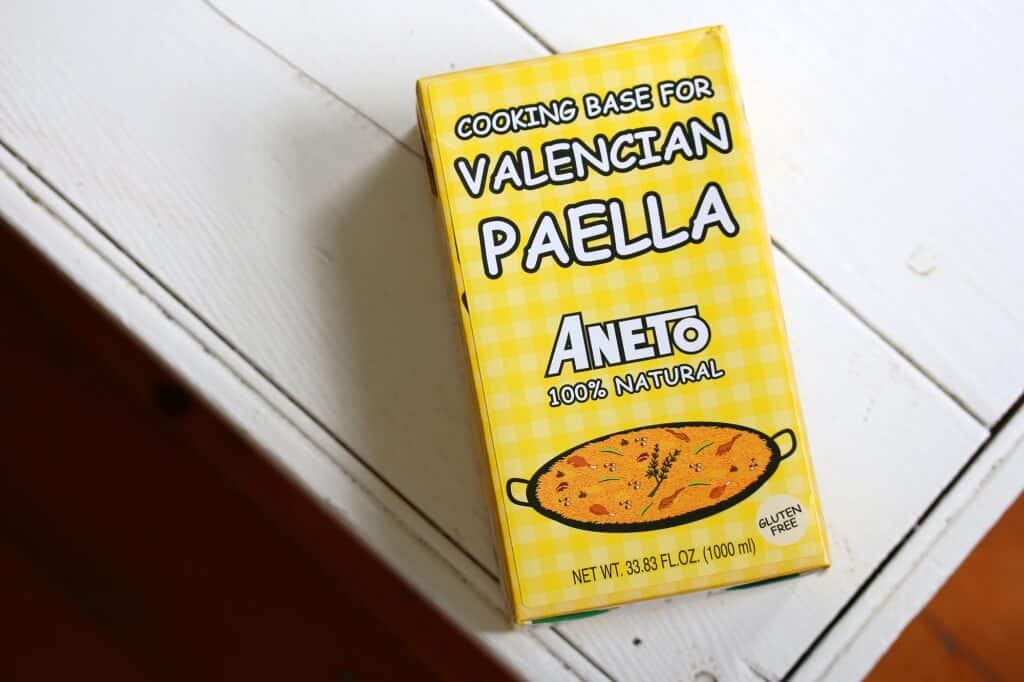
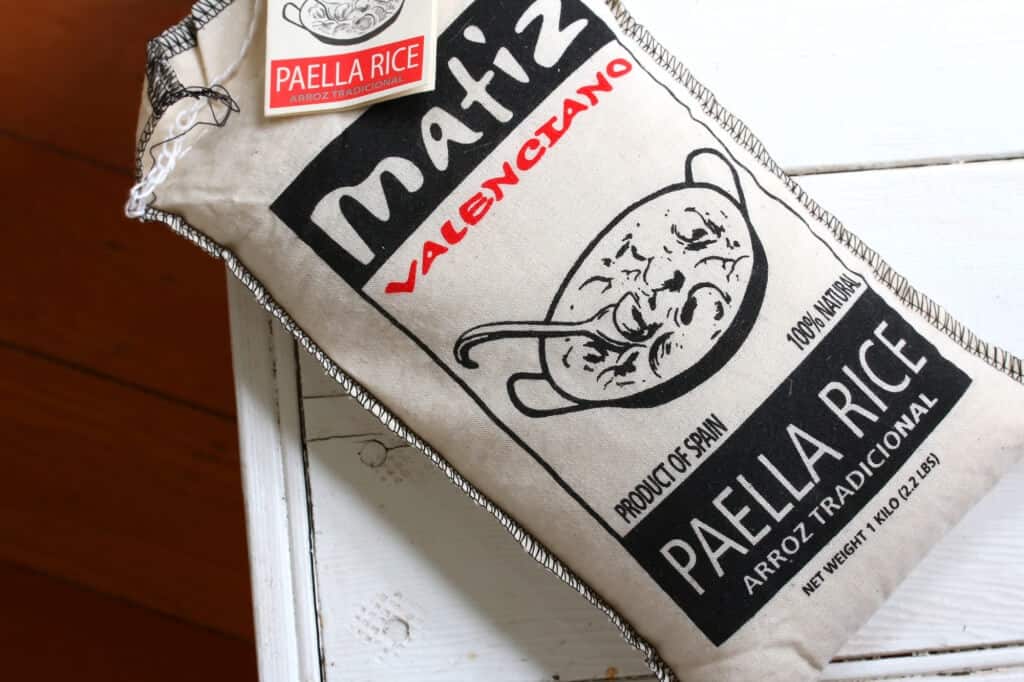
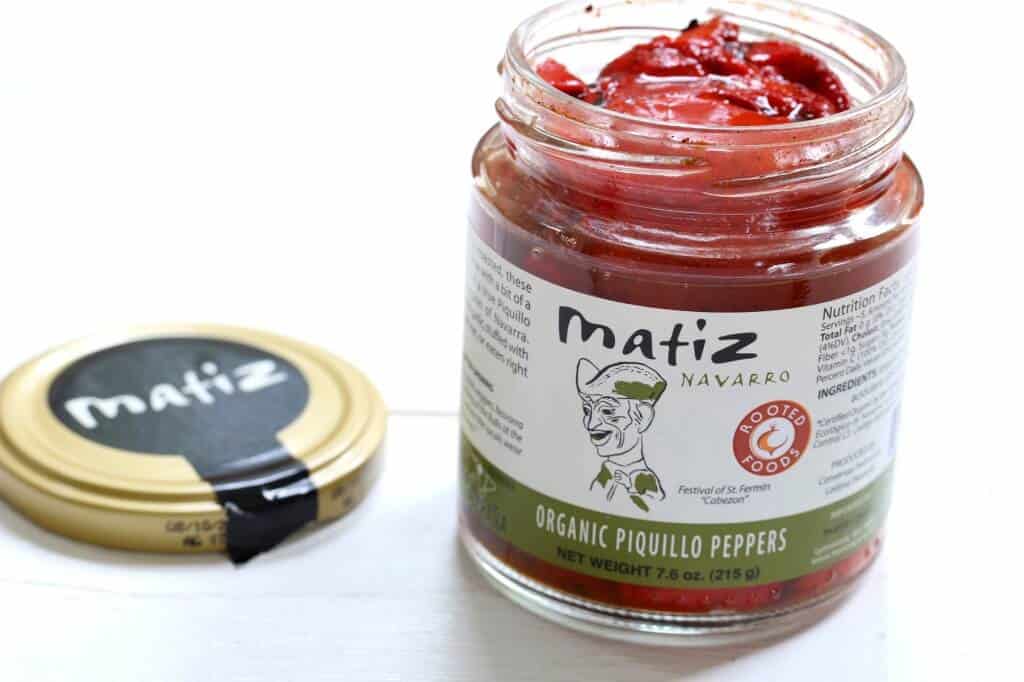
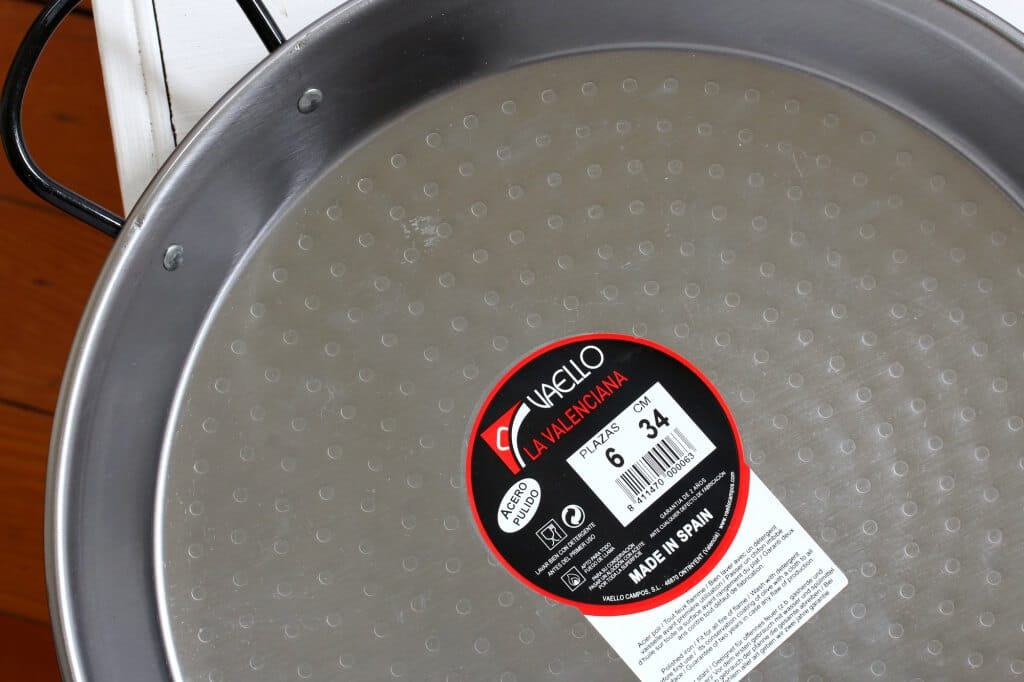
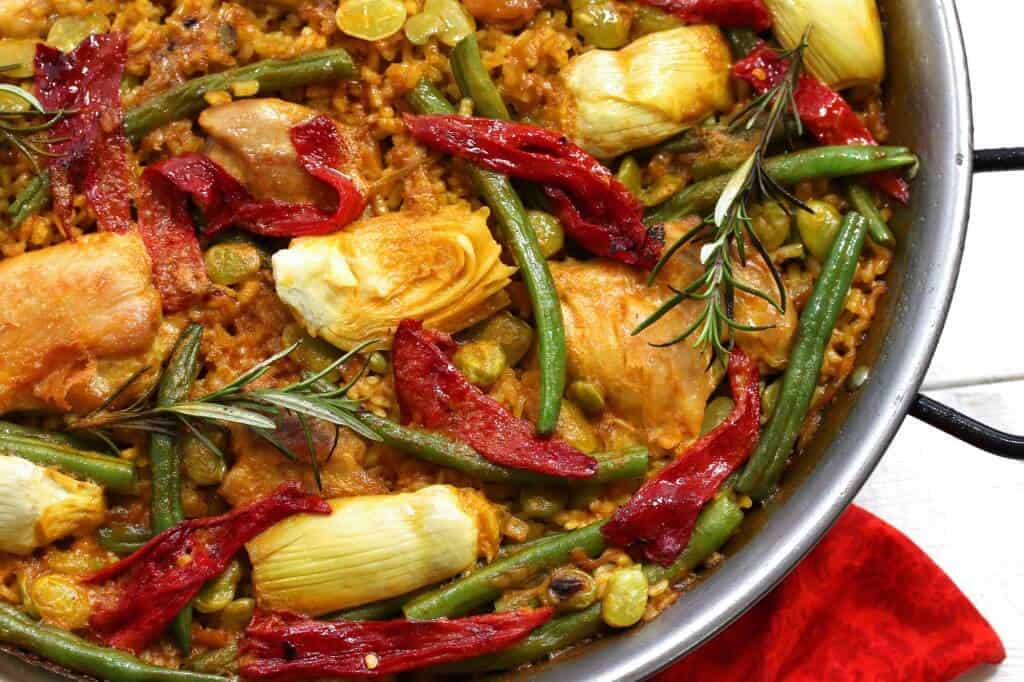
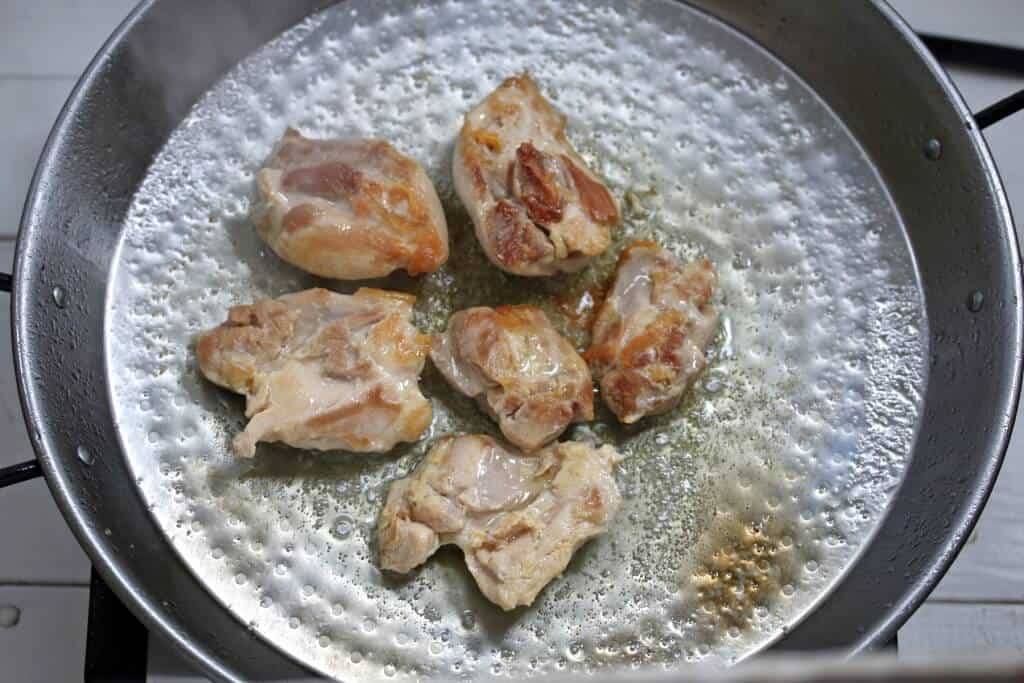
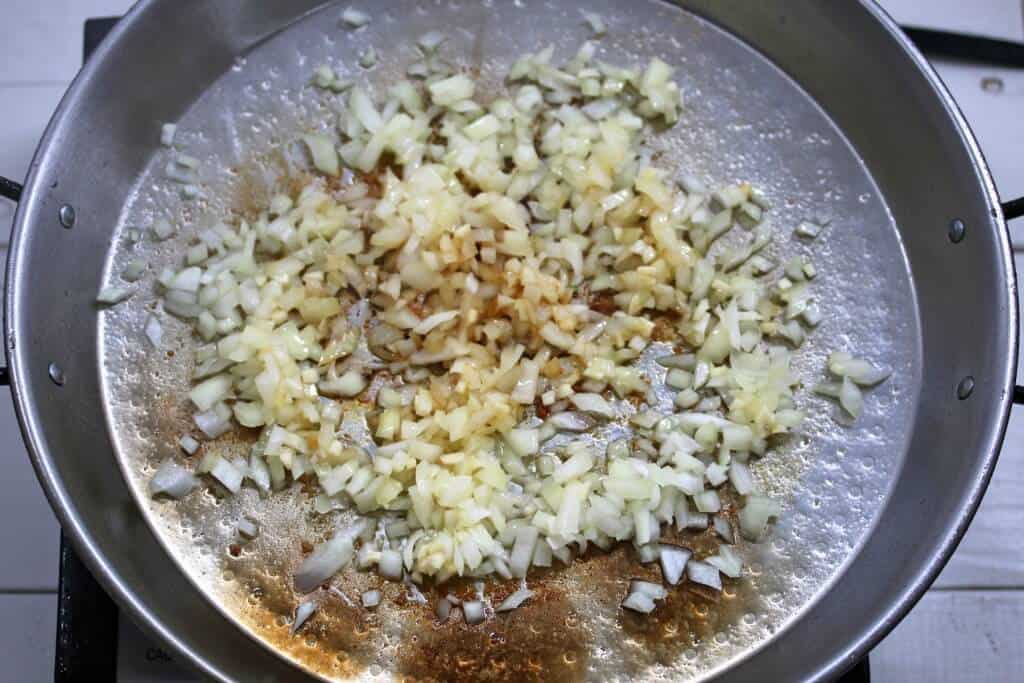
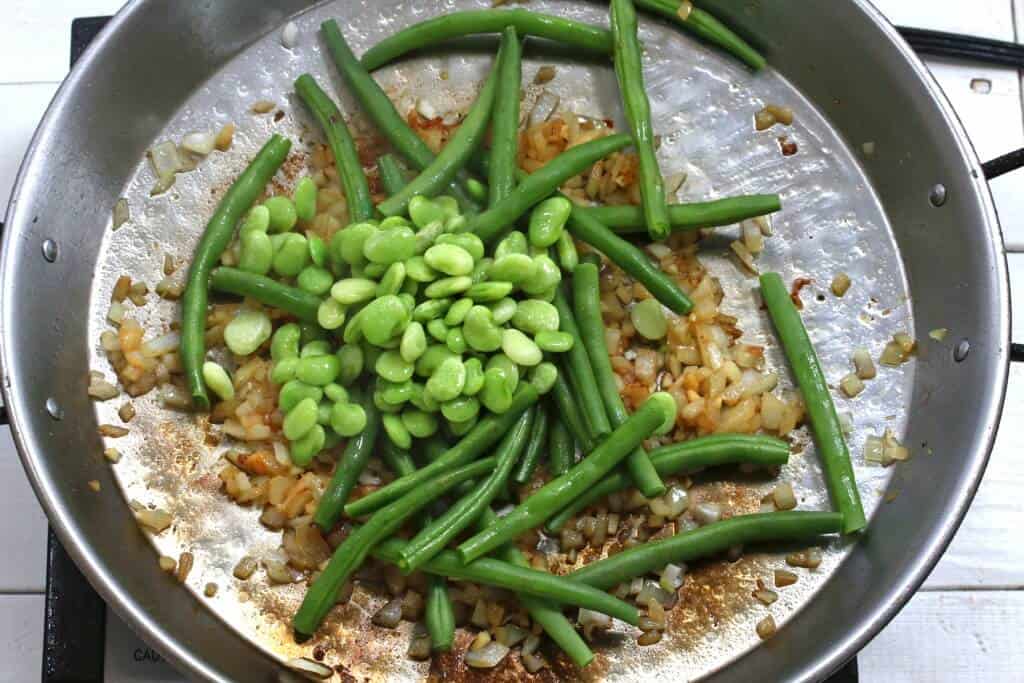
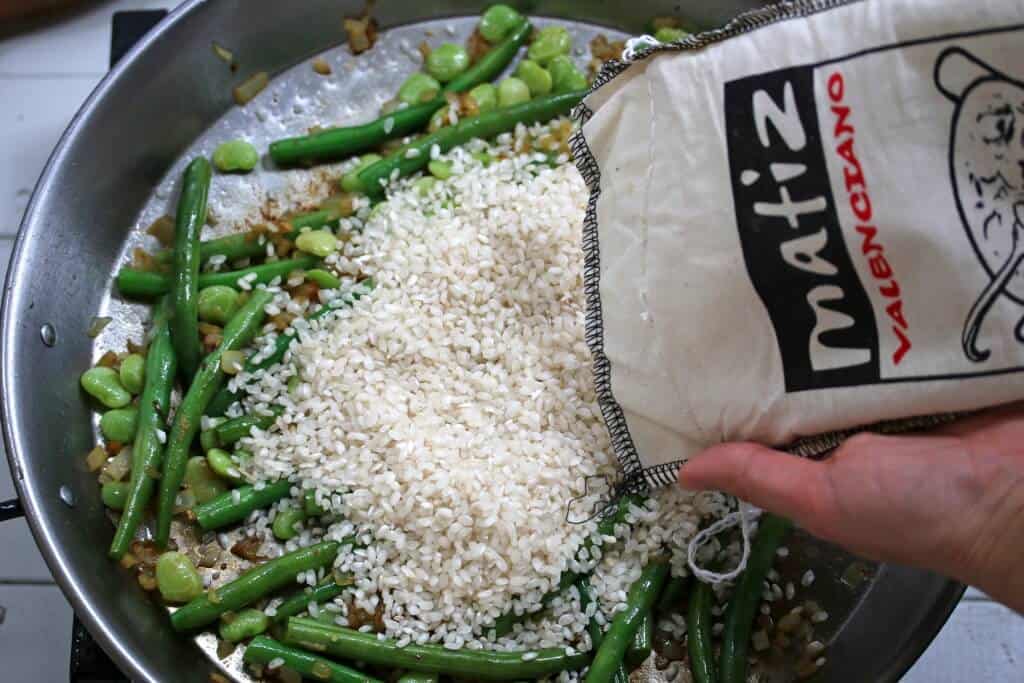
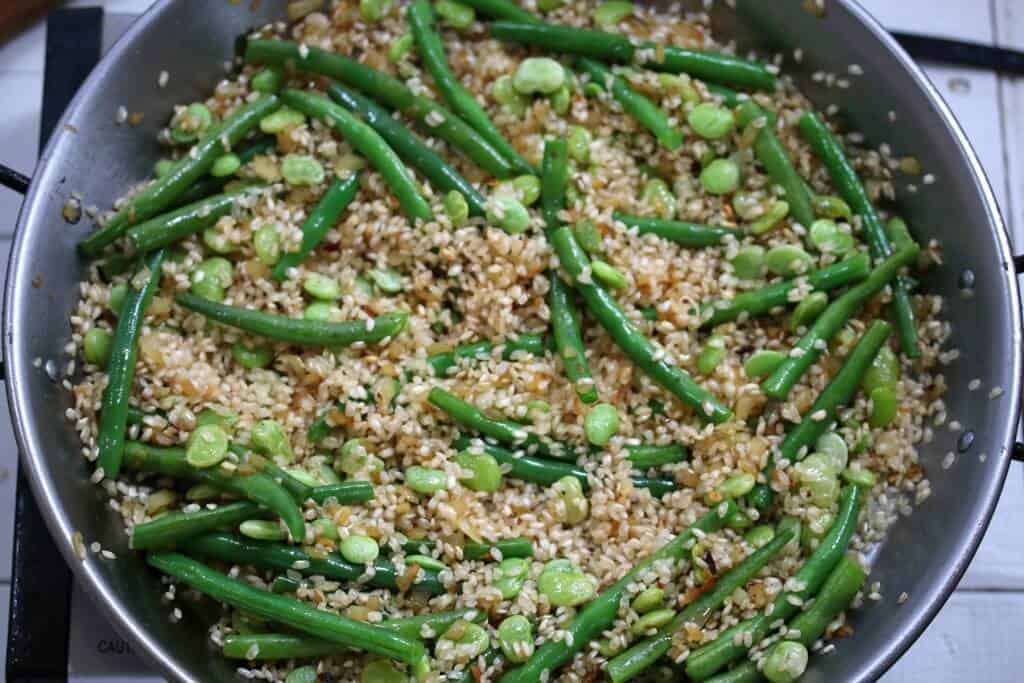
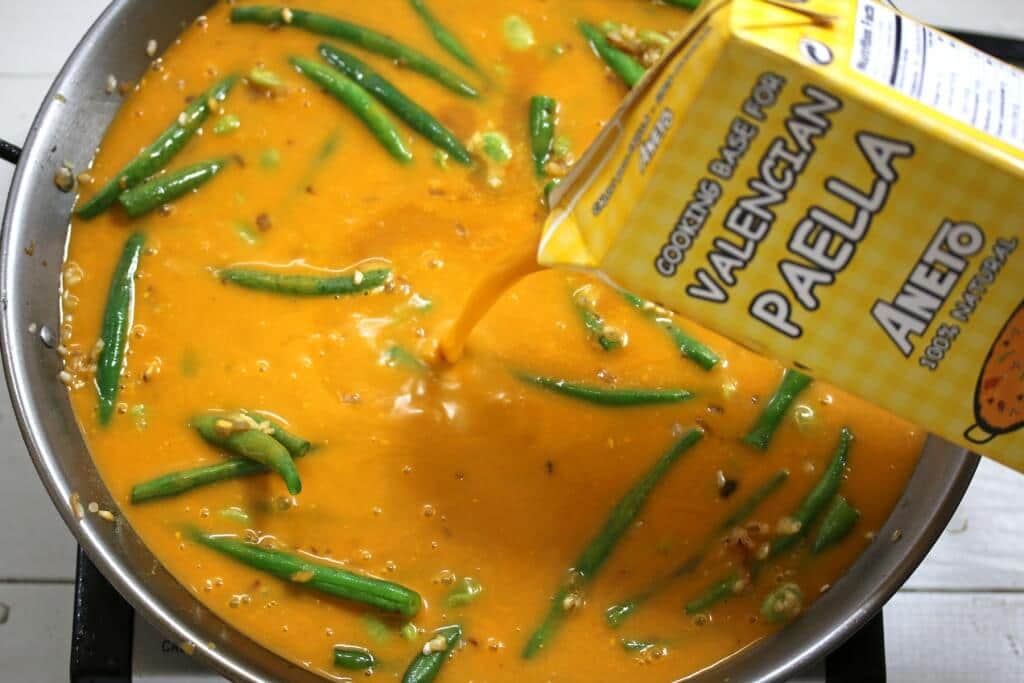
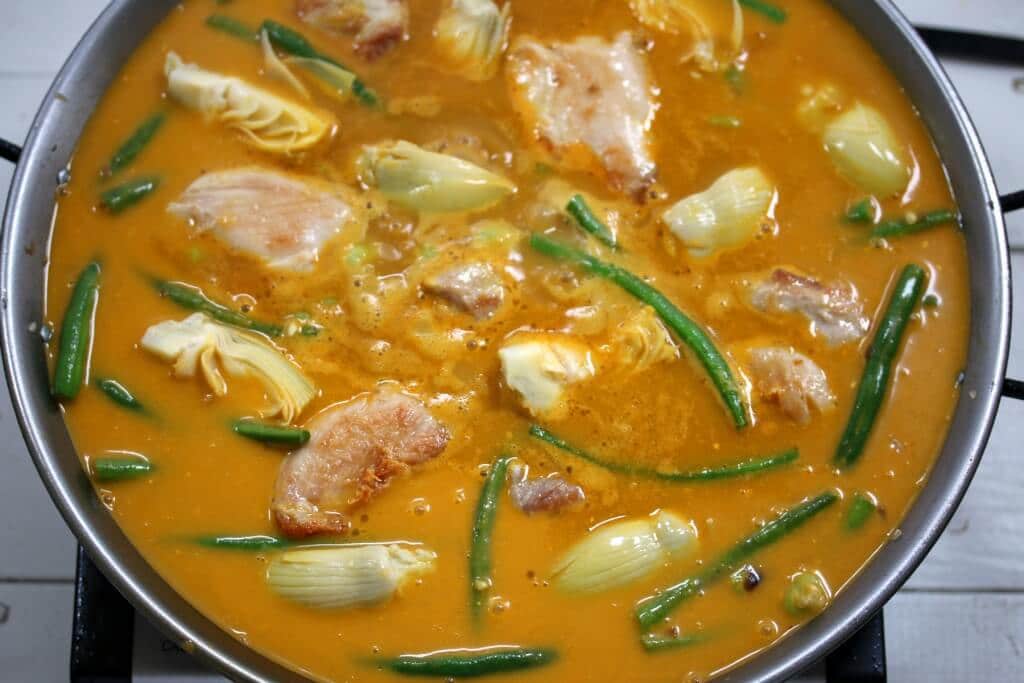
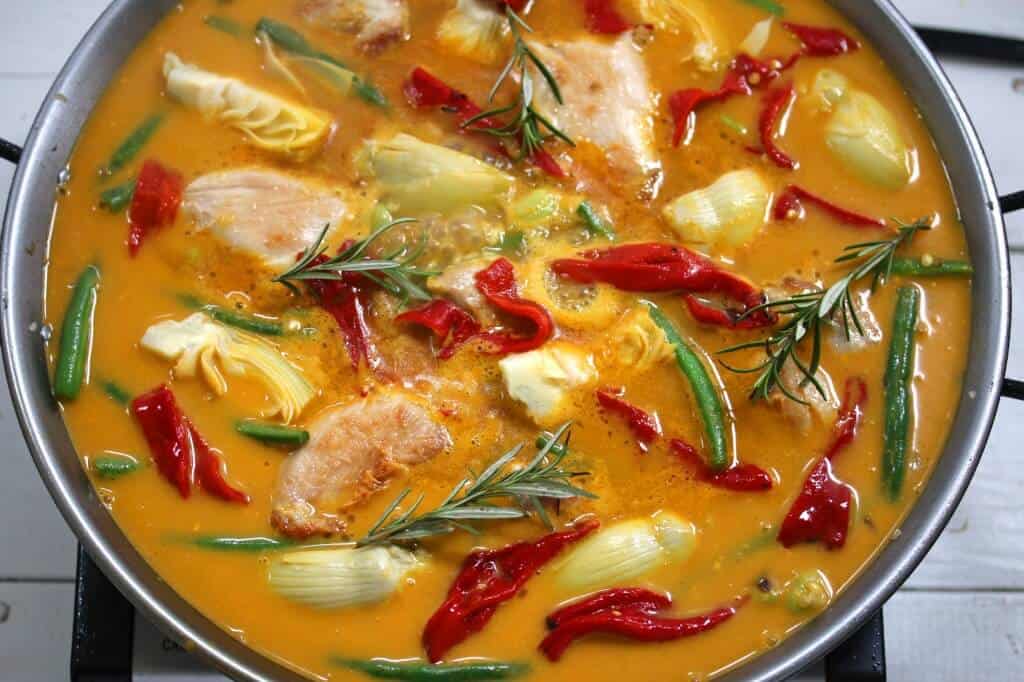
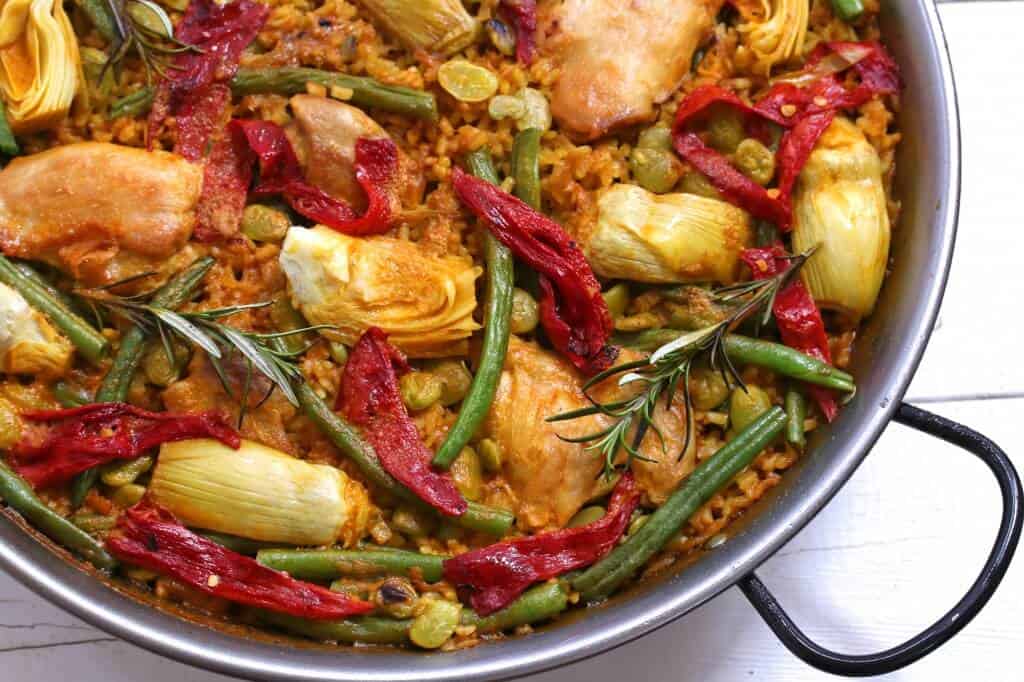


















Hi Kimberley, my name is Mayte and I come from Madrid (Spain). I must congratulate you for your wonderful paella and your interest in trying a real one. It’s difficult to find a good paella outside Valencia, but yours looks great.
Thank you so much, Mayte, I appreciate that and thank you for visiting! :)
Kimberley,
I have no access to your stock base Aneto. What else can I use ? A good chicken stock is also elusive but I could make my own.
Thanks Thai Paul
Hi Paul, yes, a good chicken stock is a must and add a pinch of saffron to the stock.
I was so glad to discover your site AND find your Paella recipe. WHY? First, I love to cook and especially like your recipe pictures. Second, I am so “tired” of my husband of 31 years talking about Paella, and why can’t I make it someday (I’m sure he is kidding-maybe). He went to Europe while in college and tells me at least once a month about the Paella he had in Spain! He loves to cook also, but he has been as hesitant to make Paella as I am. He is such a good guy that I would like to make your recipe as a surprise for our anniversary. He loves Pistachio ice cream and might try that recipe also. This will not be until end of April but I will let you know how it goes!
Wonderful, Lynn! That is so exciting – after 31 years finally a gorgeous homemade paella on your anniversary table! I hope you both enjoy the meal and yes, please let us know how it goes! (P.S. Pistachio ice cream is one of my very favorites, too :) If you end up not having the time to make it yourself, Haagen Dazs makes a good one.)
Hm.
The whole point of such dishes is meat and veggies and rice mixing their flavors.
And usually it’s – 0) oil 1) veggies 2) meat 3) water and spices 4) rice
There is no such thing as “paello broth” – it is actually prepared on step 3)
I’m not sure why s1 would fry uncooked rice in oil as in this recipe. Normally crust is formed because paella pan is large and some rice is sitting on the bottom(in oil) and some rice is not. So the browning of the rice does occur either way if that’s the goal.
Also, f.e. wiki has different recipe for “Valencia Paella”. And.. well.. removing meat and prohibiting it to be infused with flavors from veggies.. is just wrong ; )
Not to mention the fact that it’s not always all-chicken dish, f.e. commonly used rabbit should be cooked a bit longer – exactly why you add water to the meat after it’s fried.
Agreed, I wouldn’t trust everything from Wiki – yes, the meat should be simmered with everything else and yes, as mentioned in my post, Paella Valenciana traditionally incorporates rabbit and snails. Sauteing rice in oil first is a common way to approach cooking rice in general for the following reasons: 1) It helps prevent the rice from releasing too much starch while cooking, 2) Helps prevent the rice from sticking together, and 3) It helps improve the texture of the rice by preventing it from becoming mushy.
I’m from Valencia my grandfather teach me how to cook a real paella, I have to say this recipe is really good explained
Thank you very much, Jose, I appreciate that! ¡Buen provecho!
Omg i just made this dish and it came out soooo good. I did not have lima beans, artichoke and string beans and i replaced them with mushrooms and peas. I was a little worried thinking it might not come out too good because of these replacements but boy was I wrong. me and my hubby finished everything we couldn’t stop eating. Definitely the base and the special rice are everything, wouldn’t do paella without them. I also didn’t have the special paella pan and i used a 12″ deep T-fal pan. Absolutely delicious, thanks for a great recipe
Fantastic, Emilia, thank you! Agreed, the Aneto base and the paella rice are everything. So glad you enjoyed this!
Wow! Nice one! Well done! But as a Valencian paella lover, (I go to Alicante all the years), I have to say that the authentic Valencian paella, doesn’t have onion. That’s because it changes the texture of the rice and make it more glutinous, like rissotto. I’ve tried to find lots of recipes in the Internet and it’s very difficult to find one close to the traditional recipe.
Thanks for the feedback, Michael.
Thank you, Daring Gourmet for this lovely giveaway! Thank you from the bottom of my heart, as I was selected winner. I will be sure and share my first attempt at paella in my new pan as soon as I receive this wonderful gift blessing!!!
My husband & I love paella, but only eat it when dining out because it seems so complicated. Your recipe, with the step-by-step directions and pictures make me want to definitely want to give paella a try. Thank you.
My husband lived in southern Spain for a while, and we continue attempting to recreate the paella as he remembers it. A skillet just doesn’t do it justice. Thanks, and cheers to this!
I love the way the flavors of the ingredients in paella all come together to produce a magically delicious dish.
Paella is one of those dishes that I can change up depending on what I have on hand, and it’s a one pot meal that’s easy to make and satisfying.
i think it would be good fror our diet and that is why i want to try it
My husband has been diabetic for many years and I am now pre-diabetic so we have decided to follow the Michael Mosley 8 week blood sugar diet. This is basically a very low calorie Mediterranean diet. Everything that we eat noiw is made from scratch and this recipe looks like a wonderful one to continue our healthy eating plan.
Very interesting The way it is made.Would love to make.